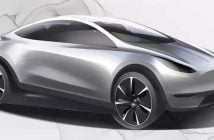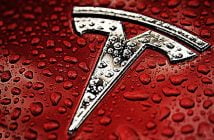+++ The BMW 7 Series, one of the brand’s most important models, will enter its 7th generation next year. Set to receive a striking redesign and a technology boost, the model will also be offered as a pure-electric car, dubbed i7, for the first time. The new luxury flagship saloon is expected to use an updated version of the modular CLAR architecture found under the current 7 Series, as well as the majority of other BMWs offered with rear-wheel drive. The platform is very adaptable, however, allowing for its use in 2 of the brand’s latest EVs (the iX and i4), allowing the new 7 to be offered in pure battery form too. BMW will introduce a distinctive new headlight design that moves the model away from its older saloons, such as the 5 Series. The current car’s combined daytime running lights and main headlamps will be ditched in favour of split units, with the latter located down in the bumper. As is customary on recent BMWs, the next 7 Series will feature huge kidney grilles, while the streamlined nose references the iX SUV. Buyers of the new luxury limo will also be able to choose between standard and long-wheelbase layouts. The rear of the new 7 Series is a little more conventional, with changes including a taller, reshaped bootlid and new, slimmer tail-lights. Higher-spec models will also be fitted with a recessed twin-exit exhaust system that’s set into a diffuser. BMW is yet to detail technical specifications for the 7 Series, or the electric i7 for that matter. We expect the model to continue to be offered with a range of 4- and 6-cylinder engines utilising 48 volt mild hybrid tech to improve efficiency. Diesel power will be offered, too, with BMW chairman Oliver Zipse confirming 4 different drive technologies will be available. It’s probable that a V8 petrol engine will return for the 750i model, too, although emissions regulations have killed off the flagship V12, in Europe at least. As for plug-in hybrids, expect significant gains in electric range and overall efficiency. The i7, which will rival the Mercedes EQS and Tesla Model S, will use the firm’s fifth-generation eDrive technology, which is also found in the i4 and iX. In the latter, a battery size of 105 kWh is offered, with an expected range target of 700 km.
+++ New-car registrations in FRANCE fell 15 percent in December, partly due to a global semiconductor shortage and as a new wave of coronavirus infections creates uncertainty. In total, 158.121 passenger vehicles were registered last month, France’s CCFA association of automakers said. For all of 2021, registrations were up just 0.5 percent at 1.66 million compared with 2020’s multi-year low. +++
+++ HYUNDAI and affiliate Kia forecast that their combined global sales will jump 12.1 % in 2022, even as last year’s sales fell short of target due to a global chip shortage. The companies sold 6.67 million vehicles in 2021, about 3.7 % less than their combined target of 6.92 million vehicles, largely due to supply problems including the chip shortage, which drove down vehicle shipments. They said they would target global sales of 7.47 million vehicles this year. “In 2022, Hyundai Motor plans to expand its market share and strengthen profitability through efforts to stabilize chip supply and demand, adjust vehicle production schedules, strengthen electric vehicle lineups as well as optimizing sales profit and loss by region”, Hyundai said in a statement. The shortage, due to supply problems and a surge in demand for consumer electric gadgets during the pandemic, has hit the auto industry hard, with millions of vehicles worldwide not being produced because important parts are missing. Analysts said this year’s target seemed reasonable. Lee Jae-il, an analyst at Eugene Investment & Securities, expected demand for vehicles to stay strong in 2022, underpinned by pent-up demand from consumers unable to buy vehicles last year due to supply shortages. “It appears that the chip shortage has been showing some signs of easing, however rising raw material prices would likely have (an) impact on their profitability”, Lee added. In October, Hyundai Motor cut its 2021 global sales target by about 4% to 4 million vehicles from 4.16 million vehicles. +++
+++ MERCEDES-BENZ will reinvent the concept of the traditional SUV as it pursues enhanced efficiency for its next-generation electric cars. At the reveal of the ultra-efficient EQXX concept, company bosses hinted at plans to introduce more aerodynamically efficient designs for its models in the crucial and ever-popular SUV segment, in an effort to provide customers with greater range per charge. Asked if the quest for greater efficiency could see a shift away from SUVs altogether, in favour of lower cars like the EQXX, chief technology officer Markus Schäfer told: “The matter of fact is that the biggest factor in achieving efficiency is aerodynamics times the factor of the size of the vehicle. Definitely we will see different shapes of SUVs. I truly believe the shape of SUVs will change, at least if efficiency matters to a car company, and it does to us. It has to drop a little bit to the rear of the car, and the width of the front and rear axles might not be the same. There are some slight optimisations that can be done to a vehicle to dramatically change the efficiency and consumption. But ultimately we have to take the customer into consideration and the customer loves SUVs, no doubt. They love SUVs and the market share is still rising, but the shape probably will change”. His comments come as Mercedes readies a new family of bespoke electric SUVs using the new MEA (or EVA2) architecture, including the EQE SUV and larger EQS SUV. Schäfer’s views were echoed by chief designer Gordon Wagener, who said “SUVs will never be as efficient as these lower cars”, citing that inevitable truth as a reason for the EQXX concept’s “low, ‘sedan-ish’ ” silhouette. SUVs’ traditionally larger frontal areas and flat, hatchback-style rear ends are not conducive to optimised efficiency, Wagener explained. “We will show you very efficienct SUVs when we launch new SUVs on the new EVA2 platform”, he promised. “They will be so much more efficient than any SUV before: a bit more ‘flowy, less boxy”. Certainly, spy shots and official previews suggest the EQE and EQS SUVs have been designed with a keen focus on aerodynamic efficiency. But, Wagener suggested, there are limits to the range-boosting effects of improved aero. “The EQS sedan will always be more efficient than the EQS SUV”, he explained. “That’s physics – you can’t change that”. +++
+++ Electric vehicles accounted for nearly two-thirds of all new car sales in NORWAY this past year, according to newly published data from the country’s Road Federation. In 2021, Norwegian dealerships sold 176.276 cars, 65 percent of which were EVs. That’s an 11 percentage point increase from the year prior when they accounted for 54 percent of all new car sales. The Tesla Model 3 was the most popular choice among new buyers followed by Toyota’s (plug-in) hybrid RAV4, the only car with an internal combustion engine to make the country’s top-10 best-selling list. Other notable cars to make the list include the Volkswagen ID.4 in third place and the Polestar 2 in the number 10 spot. The Norwegian EV Association told electric vehicle sales could make up as much as 80 percent of the country’s total car market by 2022, as long as chip shortages don’t cause further shipping delays. As in 2020, much of what’s driving EV adoption in Norway is the country’s generous subsidies. Car buyers don’t have to pay taxes imposed on traditional internal combustion engine vehicles when they buy an EV. In 2021, the country’s federal government missed out on approximately $3.41 billion in tax revenue to push forward on its plan to end all gasoline-powered car sales by 2025. +++
+++ TESLA has just announced that its EV deliveries has exceeded 936.000 in 2021, including the new quarterly record of 308.600 in the 4th quarter of 2021. The question is how high might it go in 2022, as the long estimated delivery times indicate strong demand? In general, Tesla expected that the long-term average annual growth of vehicle deliveries would be around 50%. That would be 1.4 million in 2022. However, we guess that it might be more than that, especially since in 2021 the growth was over an 87 % increase year-over-year. The starting point is over 936.000 in 2021. Assuming that the rate of 300.000+ units per quarter would be maintained for all of 2022, the company would be at 1.2 million total. But there is no reason to remain flat at a particular rate, as the company expands Model 3 / Model Y production and sales, is ramping up the refreshed Model S / Model X, as well as adding new plants. In terms of new plants, according to the latest reports, Tesla Giga Austin in Texas should start production soon, and Tesla Giga Berlin in Grünheide near Berlin, Germany also appears ready to start production. If those 2 new plants would add 300.000 together, with a maintained rate from Q4 by the plants in California and China, the total would then exceed 1.5 million. That’s 600.000 additional BEVs in a year. I believe that there is potential to go even higher than that. The 2 new plants probably will be ramping up production not only over 2022, but also in 2023; increasing volume and adding new products (just like the Tesla Giga Shanghai). To produce 1.5 million all-electric cars, Tesla will need an unprecedented amount of batteries: over 100 GWh (at an average of 70 kWh/car: 105 GWh and at an average of 80 kWh/car: 120 GWh; Tesla cars usually have a capacity from about 60 kWh to about 100 kWh. 97 % of the new Tesla cars had less than 85 kWh). +++
+++ “That’s what I get for $7,500?” A new report on the skyrocketing cost of used cars in the UNITED STATES contains this quote from a woman in Omaha, Nebraska, whose car had been totaled in a crash, and who desperately needed basic transportation for work. She got basic, all right: a 2013 Scion with 160.000 miles on it. The U.S. Bureau of Labor Statistics’ Consumer Price Index reported last month that the average transaction price of a used car in November was $26,000. Well, that average has now moved to $29,000. That’s right, up another $3 grand in a month. That’s an increase of 39 % in the past year (compared to average new car transactions that are up 13% and are approaching an average of $46,000). And used cars are one of the biggest drivers of the 6.8 % inflation rate Americans are feeling throughout the economy. It’s such a rapid and seemingly irrational increase that a lot of people who need a car are being priced out. More than half of U.S. households have less income than is considered necessary to buy a car at that $29,000 price point. In other words, unless or until this trend reverses (and industry forecasters say that’s not happening anytime soon) the days when anyone at about any income level can afford a car, to get around in a society based on car ownership, are gone. The days of a kid using savings from a part-time job to buy a car for college, also gone. As we’re pretty much all aware by now, a historic sequence of events can be blamed for the increase: 1) The pandemic lockdown led to auto production shutdowns. 2) Lowered demand for new cars during lockdown, and fewer in inventory, meant there were fewer trade-ins. 3) People stuck at home bought new computers and other electronics, so semiconductor production shifted away from vehicles. 4) When the lockdowns lifted, the economy roared back, and auto production resumed, but was hamstrung by the chip shortage. 5_ The chip shortage posed a new restriction on new-car inventories, so people needing cars turned to the used market instead. 6) And rental car companies, which had dumped fleets during lockdown, were suddenly snapping up used cars. 7) Lower supply and greater demand, meet higher prices. Last month, the average used vehicle price was 63 % of the average new vehicle cost. Before the pandemic, it was 54 %. Including taxes, fees, a 10 % down payment, and an interest rate of around 7.5 %, the average used vehicle now costs $520 a month, even when financed for the average of nearly 6 years. To make that payment and afford such other necessities as housing, food and utilities, a household would have to take home about $60.000 a year, or $75.000 before taxes, said Kimberly Palmer, a personal finance specialist at NerdWallet. In 2020, the U.S. median pretax household income was $67.521, the Census Bureau says. “The average person”, Palmer said, “can’t afford the average used car right now”. Ivan Drury, a senior analyst, said that while he doesn’t track used vehicle prices relative to household income, he thinks November marked a record “in the worst way possible for affordability”. Monthly payments for the average used vehicle, he noted, were $413 two years ago, $382 five years ago and $365 a decade ago. The November average payment of $500-plus for a used vehicle, Drury said, is about the average that was needed five years ago for a brand-new vehicle. “People are going to have to make hard decisions, maybe cut back in other areas”, Palmer said. “It means that it’s stressful for a lot of families”. David Paris, a senior manager at J.D. Power, noted that used vehicle prices are directly tied to the cost of new ones. Though some automakers report that the computer chip supply is gradually improving, prices paid by dealers at used vehicle auctions kept rising through November, Paris said. “We’re not seeing any softening in prices, which is extremely rare for this time of the year”, he said. New vehicle dealers have about 1 million vehicles available nationally; scarcely one-third of the normal supply, Paris said. And the vast majority have already been sold. Given pent-up demand from consumers, prices for new vehicles are expected to remain historically high until the supply returns to around 2 million or 2.5 million and automakers resume discounting, which could take well into 2023. Once new vehicle prices do ease, the pressure on used-vehicle prices would eventually follow. Yet even after that, the availability of vehicles will be tight because traditional sources of used vehicles (autos turned in from leases and trade-ins or sold by rental companies) have essentially dried up. For the past decade, cars returning from 2- and 3-year leases were a leading source of almost-new used vehicles. But that was when more than 33 % of U.S. new vehicle sales were leases, a figure now down to 22 %, said Drury. Because there aren’t many new autos, people with expiring leases are often buying those cars once their leases end. Rental companies, another key source of late-model used cars, can’t buy new ones now and are holding the ones they have. Some rental companies are even buying used vehicles. Given all those factors, Paris expects the shortage of used cars to worsen through 2024. Among the few consumers who stand to benefit are those who want to sell a used car and don’t necessarily need to replace it. The average trade-in value in October, Paris said, was $9.000; twice what it was a year earlier. But for people who have no vehicles to trade in and only modest incomes, the options are few to none. Palmer of Nerdwallet said lower-income people may simply have to pay for repairs to keep a current vehicle running as long as possible. Even that option, though, can become prohibitively expensive. J.D. Power’s Paris says that if they can afford it, buyers should consider a new vehicle. He recently managed to get a couple thousand dollars whacked off the sticker price on a new Ram pickup, though he had to travel from the Washington, D.C., area to Philadelphia to reach a willing dealer he had located by searching internet forums. “If you look hard enough and are willing to wait and travel”, he said, “you can find deals across most brands”. +++



